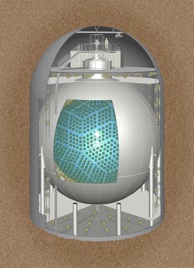Joint Workshop on Ocean Bottom Geoneutrino Detector
with Ocean Engineering, Earth Science and Neutrino Physics
July 9, 2019, in Shimizu, Japan
Home
-
✦ Scope
Anti-neutrinos emitted from radioactive isotopes inside the Earth, geo-neutrinos, bring unique and direct information on the Earth’s composition, which relate to the fundamental mysteries of its heat balance and thermal evolution. KamLAND has been stably observing geo-neutrinos with highest sensitivity since it made the world’s first observation in 2005. Understanding of the Earth using geo-neutrinos is a research field that is originally started and has been led by Japan. To date, we have set limits on the global flux of geo-neutrino that has in turned constrained the range of acceptable models for the Earth’s composition, but distinguishing the mantle flux by current detectors, which are all locate on the crust is a challenge, as the crust signal is about 70 % of the total flux plus uncertainties. Given that the oceanic crust is thin and simple, geo-neutrino detector in the ocean makes it sensitive to geo-neutrinos originating from Earth’s mantle. Ocean bottom geoneutrino detector represents a breakthrough, which goes beyond the impossibilities of the modern land-based detector, providing transformative insights into the deep Earth.
In this workshop, the scientists in the different fields, such as ocean engineering, earth science and neutrino physics will gather on the deep Earth exploration vessel “Chikyu”, which drives deep ocean bottom drilling research, to discuss specific plans toward the realization of an ocean bottom geoneutrino detector.
-
✦ Location
Meeting room on “Chikyu” at Shimizu Port
Shimizu-ku, Shizuoka City, Shizuoka Prefecture
-
✦ Organizers
-
✦ Registration
* Here is a link for registration.
-
*The deadline for registration is June 30.
-
*Considering the capacity of the meeting room, 40 will be the maximum of participants.
Kenta Ueki (JAMSTEC)
Hiroko Watanabe (Tohoku U.)
Shin’ichi Kuramoto (JAMSTEC)


Discussion Points
-
•Engineering Part
-
-Design of the detector
-
-Way to deploy in the ocean
-
-Needed technological development for building
-
•Science Part
-
-Target of observation
-
-Way to collaborate and grow together with ocean drilling and earth science
-
•Organization Part
-
-Cost estimation
-
-Timeline
-
✦ Information <Last update : 1, July, 2019>
-
*Please gather at the taxi stand at JR Shimizu Station East Exit by 9:30 am.
-
*The internet at the meeting room for participants is not available.
-
*Presentations : Please prepare your slides in English. Presentations and questions are recommended to be in English, but Japanese is also possible.
-
*Discussions : We are planning to have discussions mainly in Japanese.
-
*We will have collaboration dinner close to JR Chimizu Station from 17:30 to 19:30.
-
✦ Notes for Visiting Chikyu <Last update : 3, July, 2019>
-
*Sandals, high-heels, skirts and short pants are prohibited because there are stairs and steps on Chikyu.
-
*We recommend long sleeves as the air conditioner is strong at the meeting room.
-
*Please follow Chikyu’s safety rules which will be explained after boarding. Alcohol and dangerous goods are prohibited.
-
*Please smoke only at the designated smoking area.
-
*There are many restricted area on Chikyu. Please do not enter without permissions.
-
*There is no vending machine on the vessel for drinks. Please prepare by yourself before boarding. Several kinds of drinks (water, tea, coffee, orange juice, milk etc) are available at the cafeteria where you will have lunch.

